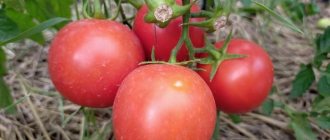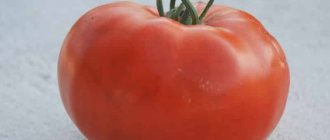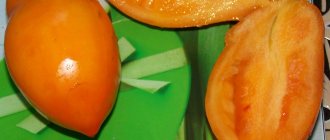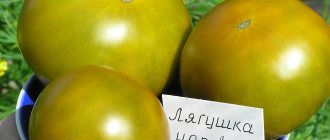Tomato Pink Miracle F1 will attract the attention of farmers who want to plant tomatoes with excellent marketability for sale, as well as gardeners who are looking for a very early variety in order to quickly start enjoying ripe fruits from their garden.
| Height | Landing location | Ripening time | Fruit color | Fruit size | Origin | Fruit shape |
| Medium height | Greenhouse, Open ground | Ultra early | Pink | Average | Hybrid | Round |
Characteristics and description of the variety
Bred in Transnistria, entered into the State Register in 2010.
Determinate bush, height 100-110 cm, medium foliage. The leaves are large, light green. The inflorescences are simple. The first inflorescence is formed above 5-6 leaves, the subsequent ones - after 2 leaves. Each cluster bears 5-7 fruits.
Reference! The term “determinant” comes from the Latin word determination, which means limitation, limit.
An early ripening hybrid, 80–85 days pass from the moment of germination to full maturation. Recommended for cultivation in open ground and in greenhouse conditions.
Productivity is high, from 1 sq. m harvest up to 19 kg of vegetables.
The culture is resistant to the main diseases of the nightshade family, such as late blight, alternaria, fusarium, tobacco mosaic. But it is often attacked by insect pests, such as the Colorado potato beetle.
The plant requires obligatory garter. As the branches grow, they become spreading, so it is better to fix them to a support. In addition, ripe fruits noticeably weigh down the hands, which may not support the weight of the vegetables.
Like gartering, pinching is an obligatory step in crop care.
The fruits are even, smooth, round in shape, the color of ripe raspberries. Weight up to 120 g, thin skin, 4-6 seed chambers. The taste is excellent, a harmonious combination of sugar and sourness. The pulp is medium dense, moderately juicy.
Ripe vegetables cannot be stored for long-term storage. If transportation is planned over long distances, then it is best to transport them unripe.
The variety belongs to the salad variety, so fresh use is preferable. They make amazing summer salads, an excellent base for hot and vegetable dishes, baking vegetables with meat - all these dishes exhibit excellent taste. In pickles and marinades, tomatoes of this variety show their taste less expressively, so they are practically not used for winter preparations.
Reviews from gardeners about growing tomatoes Pink miracle F1
The best way to tell about the advantages and disadvantages of the Pink Miracle F1 tomato is the reviews of those who have already grown this tomato. But you need to take into account the characteristics of the region, whether the care was carried out correctly, and take note of useful recommendations and conclusions.
Alla, Nizhny Novgorod
I grew this tomato for the first year. The manufacturer stated a height of 110 cm, in the greenhouse and in the open ground the plants were no more than 80 cm. The tomatoes are tasty, round in shape, weighing about 100 grams each. Productivity is good. In the greenhouse, fruiting occurs earlier, in open ground on ridges later. I wasn't sick. I plan to plant more.
Irina, Moscow region
I grew these tomatoes in open ground. The summer was rainy, but the hybrid pleased me. There were a lot of fruits, however, due to the lack of sun, they turned out not so sweet.
Oksana
My Pink Miracle tomato grew in a greenhouse. I was very pleased with the fruits, the bushes were hung with tassels, about 6 pieces each. The tomatoes ripened gradually, so they were harvested until September. This hybrid has become one of my favorites; next year I plan to grow it again, and I will plant more bushes.
Elena
I purchased the pink miracle on the advice of a friend. I only planted four bushes, but there were a lot of tomatoes. The height of the plants is about a meter, grown in a greenhouse. I really liked the color of the fruit – bright scarlet. They are very tasty in salads, but I didn’t dare use them for canning. A friend really praised these tomatoes for their delicious juice.
Tomato Pink Miracle F1 is a hybrid variety obtained during research by breeders working at NISSA. Reviews from many summer residents and scientists claim that this variety is included in the list of the best tomatoes due to its taste and aroma. The advantages of this hybrid include endurance and ease of care. However, there is one drawback - planted seeds do not produce rich harvests, except for the first one.
How to grow seedlings
Sowing of seeds begins 2 months before planting seedlings in the ground. The soil mixture is prepared from garden soil mixed with peat and river sand. All components are thoroughly mixed. To destroy pathogenic microflora, the soil is disinfected with a hot solution of potassium permanganate.
You can plant seeds in a common wooden box or in individual containers: plastic and peat pots. Before sowing, lightly moisten the soil with a spray bottle. Seeds are planted at a depth of 1.5 cm with a distance of 2 cm from each other. After sowing, the containers are covered with glass or film and left in a warm and bright room at an air temperature of at least 23 ° C.
When the first shoots appear, the seedlings are moved to a more illuminated place, for example, on a windowsill. Daylight hours should be at least 14 hours long. If there is not enough natural light, then they are illuminated with ordinary lamps.
When 2 true leaves appear, the seedlings dive, planting them in separate containers. If the grains are sown in individual plastic cups, the sprouts are transplanted into larger containers.
Water as the top layer of soil dries out. Water moderately with warm, settled water. After watering, loosening is carried out with a wooden stick - superficially, so as not to disturb the root system.
After 2 weeks, make the first fertilizing with nitrophoska. If the sprouts develop poorly, they are additionally fed with sodium humate.
2 weeks before planting the seedlings in the ground, the seedlings begin to harden. They are taken outside for several hours, and the night temperature, where the seedlings remain until the morning, is reduced to 13 °C.
Bush care
The hybrid does not require special care, all measures are standard:
- Moderate watering is required. During fruit formation, the amount of watering is increased. For irrigation, it is recommended to use warm, settled water. The irrigation procedure is carried out in the evening, strictly under the bush;
- Moistened soil needs loosening;
- Weeds are destroyed in a timely manner, as they interfere with the normal growth and development of the crop;
- Throughout the growing season, they are fed two to three times with mineral fertilizers. For these purposes, it is advisable to use a biological preparation. Fertilize the plantings with manure twice. To prepare the solution, manure is diluted in water in a ratio of 1:9. Afterwards, the resulting mixture is infused for 7 days. One liter of mixture is used for each bush;
Thanks to this fertilizing, productivity increases and the protective abilities of the crop are strengthened.
- Stepchildren are groomed once a week. To get a pair of stems, leave one stepson on top, to get three stems - two stepsons on both sides in the axils on top;
- The maximum yield can be achieved by forming a bush of two or three stems;
- Also, tomato bushes should be provided with reliable support, since the branches may break off under the mass of ripening fruits;
- When growing in greenhouses, the premises are regularly ventilated.
How to grow tomatoes
After 2 months, the seedlings are ready to be transplanted to a permanent location. The land for planting is prepared in advance, in the fall, by feeding it with organic fertilizers. Then the soil is dug up and all weeds are removed.
Planting pattern: 70 cm - distance between seedlings, 40 cm - between rows. Half a glass of wood ash and a pinch of potassium fertilizer are added to the prepared holes and filled with water. After planting, the seedlings are watered again, the soil is loosened, hilled and mulched. Loosening provides better access of oxygen to the roots, and mulching retains moisture in the beds, so the bushes are watered less often.
Regular watering is established as the sprouts take root in a new place, but not more than 2 times a week. Water moderately with warm, settled water, strictly at the root. After each watering, the soil is loosened, removing weeds with roots.
The crop is fed with organic matter twice per season. This is quite enough to improve the growth and development of the plant during the ripening period. Dilute mullein with water 1:10 or chicken manure 1:15, leave for a week, and then pour 1 liter under each plant.
Pruning is carried out to avoid excess green mass. Density leads to the development of fungal diseases, lack of sunlight, and with a large amount of greenery, it is easy to miss pests, which will lead to their successful reproduction.
If you remove excess shoots from the main stem in time, nutrients are spent on the formation of fruits, and not on the growth of unnecessary green mass. The plant is formed into 2-3 stems.
Gartering of tall bushes is required. Bushes are tied up at an early age to form a strong and even stem. The branches are also fixed to the supports, otherwise they will not support the weight of ripe fruits. A support is installed next to each bush when planting. These can be wooden stakes or metal rods.
Reference! Tomatoes cannot be planted in soil where crops of the nightshade family previously grew. This is due to the fact that they pull the same nutrients from the ground: the tomato crop will not receive enough minerals and vitamins necessary for growth and development. In addition, the likelihood of developing diseases common to nightshades increases.
Diseases and pests
Hybrid crops are characterized by increased immunity to major diseases, and the Pink Miracle f1 tomato is no exception. The main pest of vegetable crops is the Colorado potato beetle. Female beetles lay eggs on the inside of leaves, so it is important to inspect the undersides of leaves.
This pest is collected by hand and burned together with the larvae in glass jars. The beetle eats the leaves of plants of the nightshade family, which leads to their wilting. If the parasite is found in the garden beds, all crops need to be inspected, not just tomatoes.
Slugs also cause damage to tomatoes. To prevent their invasion, the beds are sprinkled with tobacco dust. Slugs are attracted to the smell of beer, and experienced gardeners set up beer traps in their gardens.
The culture does not like high humidity and rainy weather. During the wet season, they are treated with fungicidal and biological preparations. This prevents the development of fungal diseases such as late blight, various rot and mold.
Diseases and pests
Breeders have not yet developed a tomato variety that is completely resistant to diseases and pest infestation. There are more or less resistant species. The pink miracle is more stable, but there is no need to relax.
You can protect adult bushes from diseases by soaking the seeds in a special solution before planting. For disinfection and hardening, you can take regular 1% potassium permanganate. The alternative is chemicals. This will increase the protective properties and prevent the bushes from withering. Common symptoms for most diseases:
- change in growth - slowing down or sharply stretching upward;
- signs of damage on the leaves (change color, curl, dry out);
- the general appearance of the bush becomes stunted.
Most diseases develop due to improper care. Their development is provoked by irregular or weak watering, insufficient or excess feeding, and temperature fluctuations. If direct sunlight hits the leaves, this can lead to burns (tomato bushes are recommended to be shaded in hot weather).
Among the possible pests that are attracted to the foliage of this tomato are Colorado potato beetles, mites, mole crickets, wireworms, aphids, whiteflies, cutworms. Traditional methods of pest control are natural odorous substances laid out on the beds (cinnamon, onion peels, black pepper). Parasites can also be washed off with soapy water. For effective help, use insecticides.
The nuances of growing in open ground and in a greenhouse
In the southern regions, the variety is grown in open ground; in cold regions it is recommended to grow it in heated greenhouses.
Greenhouse fruits ripen earlier than in open beds.
Outdoors, the ripening of vegetables is influenced by:
- temperature;
- number of sunny days;
- amount of precipitation.
The height of greenhouse plants is slightly higher than those planted in open ground. To limit growth, pinching the crown is carried out.
In the greenhouse, not only does the fruit ripen faster, but the quantitative indicator is also higher. However, greenhouse plants are more susceptible to fungal diseases and spider mite attacks. Therefore, it is necessary to regularly ventilate indoor structures to keep plants healthy throughout the season.
If the crop is planted in regions with a temperate climate in open beds, it is necessary to have some kind of covering material on hand to protect it in case of unexpected cold weather or heavy rains.
Diseases and pests
Although this tomato variety is resistant to late blight, it can be affected by dry brown spot, brown spot or blossom end rot.
To prevent the occurrence of dry brown spotting, which is characterized by the appearance of brown spots on the ground part of the bushes, it is recommended to cover the plants with agrofibre at night. Top rot usually attacks unripe fruits, manifesting itself in rotting of their tops. Adding one tablespoon of calcium nitrate and a handful of wood ash to the holes during planting seedlings can save you from this scourge. You can spray green fruits with a solution of calcium nitrate. If brown spots, covered with a gray velvety coating, appear on the underside of the tomato leaves, this means that your tomatoes have been attacked by brown spot. You can get rid of it by spraying plants with a solution of copper sulfate.
The most common pests that can attack tomatoes of the “Raspberry Miracle” variety are: tomato moth; whitefly; spider mite; root-knot nematode; plant aphids. Treatment of plants with special biochemical preparations will help get rid of them.
The Raspberry Miracle tomato can rightfully be called a real achievement of Russian breeders.
Harvesting and application
The ripening of vegetables begins in June, the fruits ripen together, which makes them easier to harvest.
Tomatoes can be picked unripe; they are quite capable of gaining color on their own, without losing their taste.
The tomato variety belongs to the salad variety, therefore, first of all, they are used fresh. Tomatoes are good in any salad, and they complement other vegetables perfectly.
They are used to prepare hot and vegetable dishes, and are used in baking with meat. This type is not suitable for pickling and marinades, but it can be used to make tomato products, for example, juice or paste. True, the color of tomato juice will be paler. For rich color, pink tomatoes are mixed with red ones.
Ripe vegetables cannot be stored for long periods of time. They are either eaten immediately or made into canned salads.
The difference between these tomatoes is their high yield of marketable mass. Vegetables are transported over short distances with the possibility of quick sale.
The best varieties of pink tomatoes
Symbols and table capabilities:
- Possibility of sorting by columns.
- The variety's yield figures and fruit weight are rounded for ease of sorting.
- In the column: “Variety name, description, photo” is an active link to the characteristics from the State Register of the Russian Federation of a particular tomato variety and photo.
| Name_variety_of tomato | soil/heat | maturation | bush height | application | weight, g | yield Kg/m2 |
| gr/heat | average | determinant. | salad | 350 | 4 | |
| gr/heat | early | determinant. | salad | 300 | 7 | |
| gr/heat | average | indetermin. | univers. | 60 | 12 | |
| greenhouse | late | indetermin. | salad | 200 | 8 | |
| greenhouse | average | indetermin. | salad | 350 | 17 | |
| greenhouse | early | indetermin. | salad | 200 | 2 | |
| gr/heat | average | determinant. | salad | 250 | 4.6 | |
| greenhouse | early | indetermin. | salad | 220 | 13 | |
| greenhouse | late | determinant. | salad | 300 | 3.9 | |
| gr/heat | average | determinant. | salad | 300 | 8 | |
| greenhouse | 112 days | indetermin. | cherry | 23 | 3.3 | |
| gr/heat | average | indetermin. | salad | 200 | 10 | |
| greenhouse | average | indetermin. | salad | 100 | 7 | |
| greenhouse | 117 | indetermin. | univers. | 60 | 6 | |
| greenhouse | early | indetermin. | univers. | 300 | 6 | |
| greenhouse | average | indetermin. | univers. | 500 | 6 | |
| greenhouse | average | indetermin. | salad | 300 | 5.5 | |
| greenhouse | 115-medium | indetermin. | salad | 300 | 11 | |
| gr/heat | average | indetermin. | salad | 350 | 6 | |
| gr/heat | average | determinant. | salad | 180 | 3.8 | |
| greenhouse | 112 | semideterministic | salad | 280 | 8 | |
| greenhouse | average | indetermin. | salad | 250 | 7 | |
| greenhouse | 110-120 | indetermin. | salad | 40 | 8 | |
| gr/heat | average | determinant. | salad | 380 | 14 | |
| gr/heat | average | indetermin. | salad | 300 | 11 |
Abakan pink tomato
Tomato Ursa Major
Tomato Japanese crab
Tomato Miracle of the Earth
Tomato Chio-chio-san
Tomato Sugar bison
Tomato Pink Elephant
Tomato Pink Honey
Pink giant tomato
Tomato Rosamarin F1
Tomato Mikado pink
Tomato Fig pink
Tomato Wild Rose
Tomato De Barao pink
Tomato Pear pink
Tomato Oxheart pink
Tomato Cherry pink
Tomato Bull's heart pink
Tomato Bugai pink
Tomato Biysk rosen
Tomato Batyanya
Tomato Grandma's secret
Tomato Andreevsky surprise
Tomato Scarlet candles
Advantages and disadvantages of the variety
Early-ripening raspberry-colored tomatoes are always in demand on the market, despite the fact that they are practically unsuitable for winter harvesting.
However, they are so fortified that they help improve immunity. In addition, they are ideal for those who cannot eat red vegetables due to allergies. Advantages of the variety:
- ease of care;
- early maturing hybrid;
- high fruiting rate;
- resistance to major diseases;
- excellent taste of fruits;
- high content of vitamins;
- attractive presentation;
- high consumer demand;
- Possibility of breeding for sale.
Among the disadvantages of this culture, several factors are noted:
- Garter required;
- stepsoning required;
- inability to independently select seeds for the next planting;
- short shelf life;
- limited scope of application on the farm.
Farmer reviews
The opinion about the hybrid is equally positive both among entrepreneurs who are engaged in breeding any crop on an industrial scale, and among ordinary summer residents - amateurs who want to pamper themselves with unusual tomatoes:
Tatiana, Balakovo: “I grew the Macedonian pink miracle for the first time. At first the tomato was under cover, and then the film was removed. I was not sick, the ripening progressed smoothly, the fruits were sweet and soft. I liked it"
Valentina, Nizhny Novgorod region: “I grew it in a greenhouse. The bush led into 1 trunk, grew short, but prolific. There are 3-4 tomatoes on the branches, the weight reached up to 150 g. Very tasty.”
Vera, Krasnodar Territory: “My favorite tomato. Grows quickly. The fruits are not large, but aromatic. They sell well and are among the first to ripen.”
Soil requirements for planting
The Pink Miracle tomato can be grown in open beds and greenhouses. For an earlier harvest, it is recommended to plant tomatoes through seedlings. Before planting, it is necessary to carefully prepare the place and soil. When growing outdoors, the beds are made in a sunny, draft-free place.
You need to start preparing the soil for tomatoes in the fall. During the winter period, the earth will be saturated with all the necessary nutrients. What needs to be added to the soil for good and healthy plant development:
- Lime – added in autumn and spring to acidic soil. It saturates the earth with calcium and magnesium.
- Bone meal and fungicides are applied 14 days before planting seedlings.











